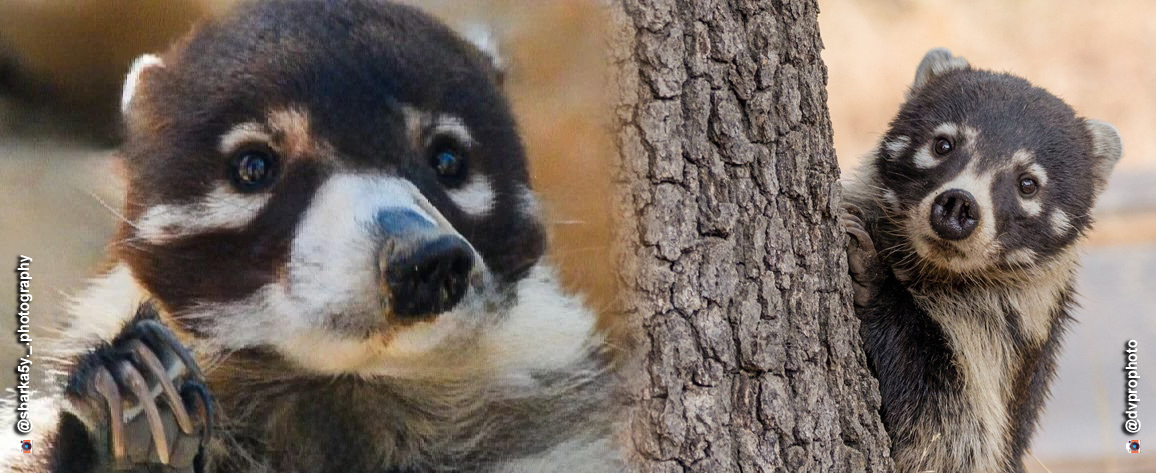
Coatimundi
If you're interested in Arizona’s unique and diverse wildlife species, you’re going to love the coatimundi. But what is a coatimundi (also known as coati) exactly? And are they dangerous? Where do coatimundi live? Where might you see one? We’ll explore the answers to all of these questions and more as we dive into the interesting world of Arizona coatis.
Pronunciation- Coatimundi: Ko-ah-ta-muhn-dee Coati: Ko-ah-tee
What is a Coatimundi?
Four distinct species of coatimundi have been identified by the International Union of Conservation of Nature (IUCN) Red List, all of them native to the Americas, although they are more common in Central and South America. IUCN lists Arizona’s white-nosed coatis as a “species of least concern” on their list of threatened species. Coatimundis are members of the raccoon family and the white-nosed coatis we have in Arizona are about the size of a small dog; males weigh up to 18 pounds and females are slightly smaller. They can be identified by their long snouts, semi-prehensile tails, and light on dark mask that often connects their white or tan nose to the rings of lighter fur around their eyes. The white-nosed coati looks like a stretched out and more slender version of a raccoon. They travel in troops and while walking, their long semi-prehensile tail is often comically visible towering above them like a furry brown (sometimes striped) periscope.
Where Do Coatimundi Live?
The white-nosed coati is distributed across a wide range, from as far north as Flagstaff, Arizona, eastward into New Mexico and Texas, and south to Mexico, Central America, and the far northwestern region of Colombia near the border with Panama. Overall, Arizona’s white-nosed coatis tend to prefer woodland and riparian habitats and rocky canyons generally at elevations from 4,500-7,500 feet. People often encounter them in southern Arizona's scenic state parks like Catalina, Oracle, and Patagonia Lake, yet they are commonly found in northern Arizona as well, with sightings reported as far north as Flagstaff and Tonto Natural Bridge State Park. So, keep your eyes peeled if you're visiting any of these areas – you never know when you might catch a glimpse of one of these fascinating and unique creatures!

What Do Coatimundi Eat?
Coatimundis are omnivores, eating everything from insects and small animals to fruit and nuts. Their long snout has a surprisingly flexible nose that is designed for digging up grubs and other delicious subterranean dwelling meals. Since they are fantastic climbers that spend a considerable amount of time in trees, they’re able to forage and hunt nearly anywhere, which greatly increases their available food options.
Are Coatimundi Dangerous?
While coatimundis are generally not aggressive towards humans, they can become aggressive if they feel threatened or cornered. It's important to keep your distance and not approach or feed them – just as you would act in any other encounter with a wild animal. If you do see a coatimundi, it's best to admire it from afar and give it plenty of space. Besides…if you get too close you run the risk of spooking them from the area and then no one gets to enjoy their antics.
Social Life
The Arizona white-nosed coati is a fascinating mammal that lives in "bands" of up to 30 individuals. These social creatures have a unique family structure in which males live separately from females and young during the fall and winter months, reuniting in the spring to breed. After the female gives birth to up to six young and returns to the band, the adult males are pushed out and the young coatis are raised and protected within the safety of their individual matriarchal-structured group. The coati's social structure allows them to work together to find food, protect their young, and defend their territory. It's amazing how these animals can form such tight-knit communities, and their family dynamics are truly a wonder to behold.
Overall, coatimundis are fascinating creatures that play an important role in their ecosystems. By learning more about them and respecting their space, we can all appreciate these unique animals while ensuring their safety and wellbeing.


